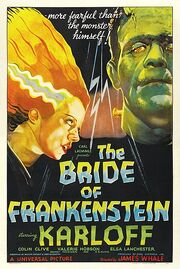 Title: The Bride of Frankenstein
Title: The Bride of Frankenstein
Author: John Balderston & William Hurlbut
Date of First Publication: 1935
Place of Publication: Pearson Weekly
Type: Short story
Characters: Victor Frankenstein (Henry); The Creature; Elizabeth Frankenstein
Themes: ANDROID; BYRONIC HERO; MAD SCIENTIST/MONSTER; QUEER FRANKENSTEIN; SYMPATHETIC MONSTER; RACE/POLITICS
Critical Summary: As Peter Haining remarks of this novel in The Frankenstein Omnibus: “The publication coincided with the opening of the picture in London on September 28, 1935 and represented another new development in the history of motion pictures—the use of the ‘tie-in’ novelization to attract audiences.” The novelette, “The Bride of Frankenstein” adapted by Guy Preston from the script by John Balderston and William Hurlburt, is a tie-in to the Whale’s much anticipated The Bride of Frankenstein.
The people of Ingolstadt celebrate the death of the Creature. Hans, whose daughter was murdered, however, wants to make sure the Creature is dead. In the process of searching for the Monster’s remains, he falls into a well. Little does he know, the Monster is still alive and in the well. Both Hans and his wife are murdered. With the monster on the loose, Victor Frankenstein and his bride are visited by doctor Pretorius who very bluntly blackmails Victor into helping him create another monster, although this time a female mate for the monster already at large. Elizabeth puts an end to this thinking and sends Pretorius away giving Minnie, her maid, instructions to keep the doctor out.
Meanwhile, the Creature is captured by yet another town, but just as quickly as they captured him the monster is loose once more this time running off into a forest injured. The Creature stumbles upon a blind man’s cottage, and since he cannot see the monster’s appearance, the two befriend each other. They remained friends until other villagers came along and destroyed the peace the old man and the monster had created. The monster flees from his destroyed sanctuary. Meanwhile, Pretorius and a few henchmen are robbing graves to look for a perfect body to use for their next creation. The Creature encounters Pretorius, and together they go to the Frankenstein household and force Henry to create a female companion. Henry remains reluctant, and so the monster kidnaps Elizabeth and runs away with her. Finally, Henry agrees to create a bride for his creation in order to get his wife back.
After several days and nights of hard work, Frankenstein has most of his creation completed save for a sound heart. Pretorius sends his servant to retrieve a heart for the new monster. Eventually, everything is in place. Frankenstein’s final step to bring his creation to life is to harness the electricity from a storm via kites and shock the Bride to life. The Monster, after realizing his dream of a bride like himself has come true, rushes to meet the new monster. However, the Bride too is frightened by the Monster and screams when she sees him. The Creature grows angry as Elizabeth appears on the scene. Henry tries to get Elizabeth to go away as the Monster is thrashing around in the background. Pretorius yells at the Monster as its hand almost hits a lever that would blow the place up. Once the creature processes what Pretorius had said, he grabs the Bride, and beckons the Frankensteins to leave. The Monster cries, “We-belong-dead!” as it pulls the lever, blowing the place to smithereens.
This work emphasizes the Creature’s desire for acceptance. His friendship to the blind man shows that the monster is capable of kindness and that the conditions he was put in made him the monster everyone perceived him to be. The addition of the second doctor is unique to this short story, and he functions as a mirror for Victor, something like Walton, but turned to evil. There is a Queer subtext in the presentation of Pretorius, tied to his desire to create life in an “unnatural way.”
Administrative Notes: Maidaly Duong, CSUF; Julissa Marie Alonso CSUF; Annette Morrison, CSUF (editing); Macy Charles (editing)
